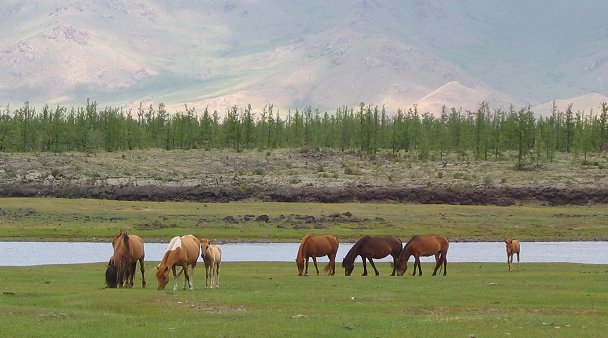| This Web book is based on public domain material provided by the US government and is available in several versions. See the editorial for more information. |

|

Home  The Society and Its Environment The Society and Its Environment  Society Society  Pastoral Nomadism Pastoral Nomadism  Constraints on Herding Constraints on Herding |
|||
| See also: Pastoralism in Practice, Collectivized Farming and Herding | |||






|
|||
Constraints on Herding
The harsh winter provides the greatest challenge to pastoralists. The herds traditionally have spent the winter eating dried grasses on the range, with at most a stone corral for shelter from the worst winter blizzards. Since the 1950s, Mongolian authorities have worked to provide shelters and fodder for the herds. Catastrophic storms, coming in midwinter or at the spring lambing season, can wipe out entire herds or severely reduce their numbers. Herders move to special winter campsites, and they reduce the size of the herd to be carried on the winter pasture by slaughtering any animals thought unlikely to survive the winter. Late fall is the only time Mongols routinely slaughter animals; the meat, preserved by drying and freezing, sustains the people during the season when neither sheep nor horses are producing milk. (Mongols do not eat horseflesh; Kazakhs do.) Mongols traditionally have consumed more milk products than meat; animals are slaughtered in seasons other than fall only for ceremonial occasions or for obligatory hospitality to guests.
Winter conditions, which severely test the Mongols' ability to sustain their herds and hence themselves, throw the society's property system and the larger political structure into relief. The key element in bringing a herd through the winter is a suitable winter campsite, which must have a source of water near terrain sheltered from the worst storms but open enough for the wind to blow snow off the grasses. The number of winter campsites is limited, and their ownership always has been well-defined. In the past, they were owned privately by families under the residual ownership of the lowest-level local administrative unit known by a number of names, banners (or koshuus in Mongol) being common. Now they are owned by the herding cooperative or state farm, which allocates them to herding camps. Outsiders, who tended to observe Mongolian herders only in the summer, mistakenly assumed that they wandered randomly across an undifferentiated sea of grass. From a Mongolian perspective, however, the landscape was far from undifferentiated, and each move of a camp reflected a careful decision that matched the needs of the herd with an estimate of the condition of the grasses and the water supply at several known sites within a large, but bounded, territory. Traditionally, Mongols thought of ownership and territory not, as an agriculturalist would, in terms of square kilometers or hectares of ground with a sharp line around them, but as rights to use certain strategic areas in the landscape, such as springs, streambanks adjacent to good pasture, or named and permanent winter campsites. Such areas were the objects of conflict between and among groups of herders; the larger political structure, both past and present, regulated access to these key resources and adjudicated claims to them.
|
|||
Home  The Society and Its Environment The Society and Its Environment  Society Society  Pastoral Nomadism Pastoral Nomadism  Constraints on Herding Constraints on Herding |
|||
Last Update: 2010-12-07


